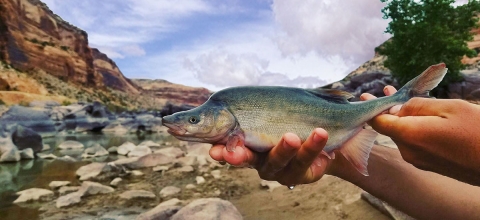Endangered Species Act Milestones: 2020s
The beginning of the new decade has so far seen many successes in the face of ongoing conservation challenges. Our growth into a nation of more than 300 million people inevitably creates more threats to the health and well-being of our native fish, wildlife, and plant species. Much of the decade remains unwritten, but maintaining a strong, effective ESA – one that is responsive to both the needs of our imperiled resources and the concerns of our citizens – is high on the U.S. Fish and Wildlife Service's agenda. All Americans can take pride in the fact that, under the ESA, the black-footed ferret, western snowy plover, and humpback chub have rebounded from the brink of extinction. We can also celebrate the fact that many species no longer need the ESA's protection and have been removed from the list of threatened and endangered species, including the Kirtland's warbler, running buffalo clover, and snail darter.
2020
- The Hawaiian hawk is delisted following recovery. Read the news release.
- The Service announces a record high piping plover population along the Atlantic Coast. Read the news release.
- Biologists report survey findings indicating a the winter whooping crane population is stable and expanding its range along the Texas coast. Read the news release.
- California condors are spotted in Sequoia National Park for the first time in nearly half a century. Read the news release.
- A snorkel survey finds 2,342 endangered Moapa dace in Nevada's Muddy River system—nearly an 80 percent increase from the previous year. Read the news release.
- Partnership-driven efforts lead to reclassification of the American burying beetle from endangered to threatened. Read the news release.
- A Kirtland’s warbler census shows the once-endangered songbird continues to flourish following their October 2019 removal from the federal list of endangered species. Read the news release.
- The Service reclassifies the June sucker from endangered to threatened, crediting critical partnerships. Read the news release.
2021
- The interior least tern is delisted following recovery. Read the news release.
- Partners involved in the effort to recover the black-footed ferret celebrate the birth of Elizabeth Ann, created from the frozen cells of Willa, a ferret that lived more than 30 years prior. Read the news release.
- The Service and partners pave the way for the return of California condors to the Pacific Northwest after a 100-year absence. Read the news release.
- After decades of protection and conservation efforts, Texas' critically endangered Attwater's prairie-chicken population reaches its highest since 1993. Read the news release.
- The humpback chub is reclassified from endangered to threatened. Read the news release.
2022
- The Morro shoulderband snail is reclassified from endangered to threatened. Read the news release.
- The Stephens' kangaroo rat is delisted following recovery. Read the news release.
- Collaborative conservation efforts lead to reclassification of the beach layia, a coastal California beach plant, from endangered to threatened. Read the news release.
- A record number of whooping cranes – an estimated 543 – arrive at their Texas wintering grounds. Read the news release.
- The smooth coneflower is reclassified from endangered to threatened. Read the news release.
- Scientists count 263 Devils Hole pupfish—the most observed in 19 years. Read the news release.
- The snail darter is delisted following to recovery. Read the news release.
- The Santa Cruz Island dudleya and island bedstraw, two Channel Island plant species, are delisted following recovery. Read the news release.
2023
- The Fender's blue butterfly is reclassified from endangered to threatened as a result of partnership-driven conservation. Read the news release.
- The Service declares five species – San Clemente Island paintbrush, lotus, larkspur and bush-mallow plants and San Clemente Bell’s sparrow – as fully recovered. Read the news release.
- Following decades of successful conservation and large-scale restoration work, the Service proposed removing the wood stork from the federal list of endangered and threatened species. Read the news release.
- For the first time since reintroduction into the wild, the population of Mexican wolves in Arizona and New Mexico soars past 200. The milestone comes at the 25th anniversary of reintroduction efforts. Read the news release.
- The Service finds ESA protections are no longer needed for Colorado hookless cactus and propose removing the species from the list of federally threatened and endangered species. Read the news release.
- The Service announces the recovery of Furbish's lousewort, one of the first federally protected plants, crediting decades of conservation efforts by partners, including the forest products industry. Read the news release.
- The Service announces the successful recovery of golden paintbrush. Read the news release.
- The Service announces the recovery of the Okaloosa darter, crediting long-term partnerships with federal, state, local and private citizens. Read the news release.
- The Service proposes removing the Apache trout from the list of Endangered and Threatened Species. The recovery of Arizona's state fish is a culmination of decades of hard work and the cooperation of many partners. Read the news release.




